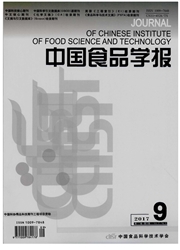

 中文摘要:
中文摘要:
采用琼脂扩散法测定鲶鱼体表黏液提取物(CEME)的抑菌活性;以腐败希瓦氏菌为研究对象,探讨CEME的抑菌机理。研究结果表明:CEME对革兰氏阳性菌和革兰氏阴性菌均有抑菌活性,具有广谱抗菌性,最小抑菌浓度在0.078~0.625 mg/m L;CEME能有效减缓腐败希瓦氏菌的生长速率;使用扫描电镜发现CEME对腐败希瓦氏菌的细胞形态结构造成明显的损伤,有效破坏微生物细胞膜的完整性;同时CEME还导致腐败希瓦氏菌细胞膜的通透性增加,从而使体内小分子物质以及部分大分子物质向外泄漏;应用SDS-PAGE方法发现CEME处理对腐败希瓦氏菌的总蛋白和细菌膜蛋白均有一定的影响,它能够抑制菌体某些蛋白的合成,导致胞内蛋白含量下降和缺失。
 英文摘要:
英文摘要:
In this study, the agar diffusion assay was utilized to investigate the antibacterial activities, and the action mechanism of CEME against Shewanella putrefaciens was detected. The data from minimum inhibitory concentration (MIC) values showed that CEME effectively inhibited the growth of all tested bacterial pathogens, and the MIC values were ranging from 0.078 to 0.625 mg/mL. CEME morphologies of bacteria treated with CEME were investigated by scan- ning electron microscopy (SEM), which indicated that the primary inhibitory action of CEME was to damage the bacteri- al cell membranes. CEME also increased the permeability of the outer and inner membranes of Shewanella putrefaciens and disrupted the cell membrane with the release of small cellular molecules. As a result, CEME resulted in the loss of the barrier function and induced slight leakage of nucleotide. SDS-PAGE method showed that CEME treatment had a certain effect on total protein and membrane proteins of ShewaneUa putrefaciens, which could inhibit the synthesis of certain protein, therefore resulted in the decline and loss of intracellular protein content.
 同期刊论文项目
同期刊论文项目
 同项目期刊论文
同项目期刊论文
 期刊信息
期刊信息
